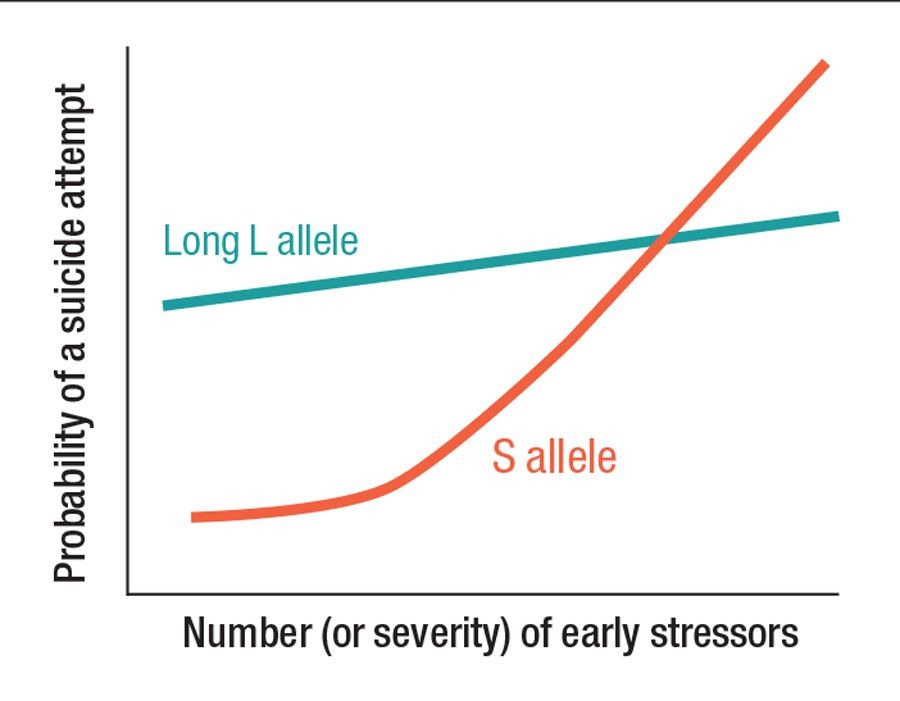Publication
Article
Psychiatric Times
The Serotonin Transporter Gene: What's New?
Author(s):
Striking findings on the relationship between stress and depression.
Figure. Schematic representation of allele effects on suicide attempts

BRIEF COMMUNICATION
The story of the serotonin transporter gene length difference and depression has a long history, which I recently reviewed.1 The 2003 study by Caspi and colleagues2 showed that the short version of the serotonin transporter gene, the S allele, is associated with a greater risk of depression-if the bearer experienced adverse childhood events.
Recently, another study––one of the few to investigate this relationship in bipolar disorder––replicated Caspi and associates’ main finding. Benedetti and colleagues3 found that the S allele was associated with greater mood disturbance, as evidenced by suicide attempts.
Several features warrant attention in this study.3 First, it shows that this relationship holds in bipolar as well as unipolar mood disorders. Second, the replication strengthens the original observation in the Caspi study. But this time, another finding that had been hinted at in other studies was very powerfully demonstrated: the S allele was associated with substantially lower rates of suicide attempt, relative to the long L allele, when childhood adversity scores were low. This finding is shown schematically in the Figure.
The same relationship was seen whether number or severity of stressors was used, as quantified by the Social Readjustment Rating Scale, a validated instrument for assessing life-changing events.
Although this finding had been hinted at before, this study is one of the best demonstrations that the S allele is neither a risk gene nor a bad gene, but rather a plasticity gene-one that makes an individual more sensitive to his or her childhood environment.3,4 If that environment is safe and nurturing, it appears that somehow this safety is introjected such that later disappointments, stresses, or depressions do not bring the individual to the brink of suicide.
On the other hand, if the childhood environment is harsh, a propensity toward high-risk behaviors is fostered (the S allele under these circumstances is associated with earlier sexual activity and more substance use, for example).5,6
A final striking finding: the relationship between severity of stressors and suicide attempts, shown schematically in the Figure, follows a remarkably linear relationship. The graphed lines are not just smoothed curves for a scattering of data points, as one so often sees. In this study, each data point follows the previous one precisely along the curves shown here. The connection between the 2 variables seems exceptionally strong.
This article was originally posted on 9/10/2015 and has since been updated.
Disclosures:
Dr Phelps is Director of the Mood Disorders Program at Samaritan Mental Health in Corvallis, OR. He is the Bipolar Disorder Section Editor for Psychiatric Times.
References:
1. Phelps J. Knowing one’s genome: are we ready? Psychiatric Times. July 31, 2015. http://www.psychiatrictimes.com/bipolar-disorder/knowing-ones-genome-are-we-ready. Accessed August 25, 2015.
2. Caspi A, Sugden K, Moffitt TE, et al. Influence of life stress on depression: moderation by a polymorphism in the 5-HTT gene. Science. 2003;301:386-389.
3. Benedetti F, Riccaboni R, Poletti S, et al. The serotonin transporter genotype modulates the relationship between early stress and adult suicidality in bipolar disorder. Bipolar Disord. 2014;16:857-866.
4. Belsky J, Jonassaint C, Pluess M, et al. Vulnerability genes or plasticity genes? Mol Psychiatry. 2009;14:746-754.
5. Kogan SM, Beach SR, Philibert RA, et al. 5-HTTLPR status moderates the effect of early adolescent substance use on risky sexual behavior. Health Psychol. 2010;29:471-476.
6. McHugh RK, Hofmann SG, Asnaani A, et al. The serotonin transporter gene and risk for alcohol dependence: a meta-analytic review. Drug Alcohol Depend. 2010;108:1-6.






